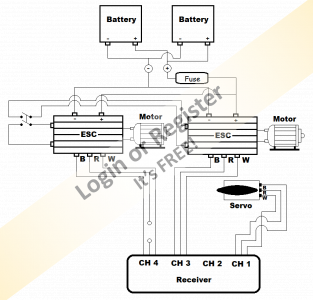Join Us On Social Media!
Electronic Speed Circuit (ESC) with Battery Eliminator Circuit
12 Posts · 8 Followers · 4 Photos · 26 Likes
Began 5 months ago by
Follow This Thread
Not currently following
> Click to follow
> Click to follow
Latest Post 5 months ago by
( Newest Posts Shown First )
📝 Electronic Speed Circuit (ESC) with Battery Eliminator Circuit
28 Views · 1 Like
Country: 🇺🇸 United States
Online: 48 seconds ago
Online: 48 seconds ago
Doug some weird things happened when I was editing previous posts and they got lost (signing out before posting the changes) in the land of the electrons. So I created new posts then realized the two got un-lost, hence the ".".
Lew
Lew
▲
⟩⟩
Len1
Lew Zee (LewsModelBoats.org)
📝 Electronic Speed Circuit (ESC) with Battery Eliminator Circuit
28 Views · 1 Like
Country: 🇩🇪 Germany
Online: 1 hour ago
Online: 1 hour ago
Very strange!
Sumptink has gone AWOL here.🤔
Lew: Why have you reduced two of your posts to just "." ?
Cheers, Doug😎
Sumptink has gone AWOL here.🤔
Lew: Why have you reduced two of your posts to just "." ?
Cheers, Doug😎
▲
⟩⟩
Len1
Young at heart 😉 Slightly older in other places.😊 Cheers Doug
📝 Electronic Speed Circuit (ESC) with Battery Eliminator Circuit
38 Views
Country: 🇺🇸 United States
Online: 48 seconds ago
Online: 48 seconds ago
.
▲
⟩⟩
No likes yet
This member will receive 1 point
for every like received
This member will receive 1 point
for every like received
Lew Zee (LewsModelBoats.org)
📝 Electronic Speed Circuit (ESC) with Battery Eliminator Circuit
47 Views · 1 Like
Country: 🇨🇦 Canada
Online: 8 days ago
Online: 8 days ago
Well said and explained.
I get many enquiries regarding hookups.
I get many enquiries regarding hookups.
▲
⟩⟩
Len1
📝 Electronic Speed Circuit (ESC) with Battery Eliminator Circuit
42 Views · 4 Likes
Country: 🇩🇪 Germany
Online: 1 hour ago
Online: 1 hour ago
Hi BobbyN,
Excellent diagrams👍
But! As recently mentioned in another thread:
one other recommendation for twin or more motors; individual fuses in the red power lines from the motor battery to each ESC, or better in the + line from each ESC to it's motor.
Helps to prevent burnouts in motor and/or ESC if the propeller snags and stalls on rubbish in the pond. Fuse value should be a few amps less than the stall current value of the motor.
Then if only one prop is stalled you can still get the boat home on the remaining shaft.😀
Cheers, Doug😎
Excellent diagrams👍
But! As recently mentioned in another thread:
one other recommendation for twin or more motors; individual fuses in the red power lines from the motor battery to each ESC, or better in the + line from each ESC to it's motor.
Helps to prevent burnouts in motor and/or ESC if the propeller snags and stalls on rubbish in the pond. Fuse value should be a few amps less than the stall current value of the motor.
Then if only one prop is stalled you can still get the boat home on the remaining shaft.😀
Cheers, Doug😎
▲
⟩⟩
SimpleSailor
Len1
River Rat
hermank
Young at heart 😉 Slightly older in other places.😊 Cheers Doug
📝 Electronic Speed Circuit (ESC) with Battery Eliminator Circuit
46 Views · 2 Likes
Country: 🇺🇸 United States
Online: 48 seconds ago
Online: 48 seconds ago
Re: increasing current draw by hacking the red wires might be possible. I'm not sure about the signal wire operating another device's red/black wires would work. (I was trying to stick with the everyday common setups for ESC's).
However, I did find this interesting picture of the "castle 2.0 bec wiring" circuit (see photo) on the forum shown (link in picture). It looks like the power outputs from the battery 8.4V go to the ESC and 6V go to the receiver. Now the 8.4V output of the ESC goes to the add on BEC (not the one in the ESC). That might be labeled incorrect and should be 6V (???).
My other concern is the commonality between the two BEC 6V red/black outputs. Sure, they both come from the same battery but through different circuits.
I'm not sure the fan in connected in series between the 2nd BEC and the servo. Not sure if or where the signal/programming port is connected.
I have to defer this concept to someone with more electronics design experience🙄. I'm (was) only an electro-mechanical packaging designer.)
Has anyone else here tied this or have any theories? I think this circuit would work well for someone needing more controllable/adjustable current for a large servo or crane.
Lew (retired 27 years)
Florida 😎, USA

However, I did find this interesting picture of the "castle 2.0 bec wiring" circuit (see photo) on the forum shown (link in picture). It looks like the power outputs from the battery 8.4V go to the ESC and 6V go to the receiver. Now the 8.4V output of the ESC goes to the add on BEC (not the one in the ESC). That might be labeled incorrect and should be 6V (???).
My other concern is the commonality between the two BEC 6V red/black outputs. Sure, they both come from the same battery but through different circuits.
I'm not sure the fan in connected in series between the 2nd BEC and the servo. Not sure if or where the signal/programming port is connected.
I have to defer this concept to someone with more electronics design experience🙄. I'm (was) only an electro-mechanical packaging designer.)
Has anyone else here tied this or have any theories? I think this circuit would work well for someone needing more controllable/adjustable current for a large servo or crane.
Lew (retired 27 years)
Florida 😎, USA

▲
⟩⟩
Len1
hermank
Lew Zee (LewsModelBoats.org)
📝 Electronic Speed Circuit (ESC) with Battery Eliminator Circuit
53 Views · 5 Likes
Country: 🇦🇺 Australia
Online: 7 days ago
Online: 7 days ago
Hi All
Thought I would make a contribution to this topic. Attached are two basic circuit diagrams that our Association uses. The first one shows a single battery powering a single screw boat using an ESC with a BEC. The secong diagram shows a twin screw boat powered by two batteries in parallel. We use channel 4 because we have an upgrade to the flysky i6 which creates a twin throttle.
Hope this contributes.


Thought I would make a contribution to this topic. Attached are two basic circuit diagrams that our Association uses. The first one shows a single battery powering a single screw boat using an ESC with a BEC. The secong diagram shows a twin screw boat powered by two batteries in parallel. We use channel 4 because we have an upgrade to the flysky i6 which creates a twin throttle.
Hope this contributes.


▲
⟩⟩
SimpleSailor
MouldBuilder
hermank
RNinMunich
flaxbybuck
📝 Electronic Speed Circuit (ESC) with Battery Eliminator Circuit
60 Views · 1 Like
Country: 🇬🇧 United Kingdom
Online: 6 hours ago
Online: 6 hours ago
If you are using any form of high power servos, you should use a BEC that is capable of delivering the sum of the current required by them under load. The negative wires of the BEC and the ESC will be treated as common and therefore connected. The receiver can be powered by either the BEC or the ESC red wire but often the voltage required by high power servos is more than the receiver can handle, in that case use the positive from the ESC and use the BEC positive only for the servos. The control of the servos is via the signal lead, usually white, from the receiver. The return circuit is provided by the common negative leads. In large model aircraft electronic devices are used that provide for two batteries and two receivers and in some cases dual servos, the reason for this is fail safe and redundancy. If this is confusing, let me know and I will draw up a schematic.
🤔
🤔
▲
⟩⟩
Len1
📝 Electronic Speed Circuit (ESC) with Battery Eliminator Circuit
61 Views · 1 Like
Country: 🇬🇧 United Kingdom
Online: 13 hours ago
Online: 13 hours ago
Great post Lew 👍
Philuk
Philuk
▲
⟩⟩
Len1
📝 Electronic Speed Circuit (ESC) with Battery Eliminator Circuit
64 Views · 1 Like
Country: 🇺🇸 United States
Online: 48 seconds ago
Online: 48 seconds ago
.
▲
⟩⟩
hermank
Lew Zee (LewsModelBoats.org)





 Commodore
Commodore United States
United States Fleet Admiral
Fleet Admiral Chief Petty Officer 2nd Class
Chief Petty Officer 2nd Class Petty Officer 1st Class
Petty Officer 1st Class Midshipman
Midshipman Warrant Officer
Warrant Officer











